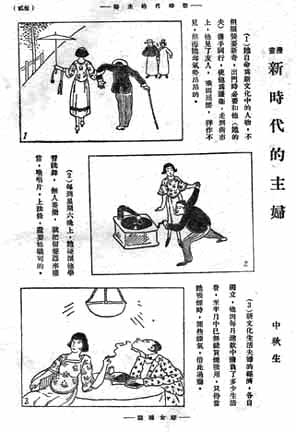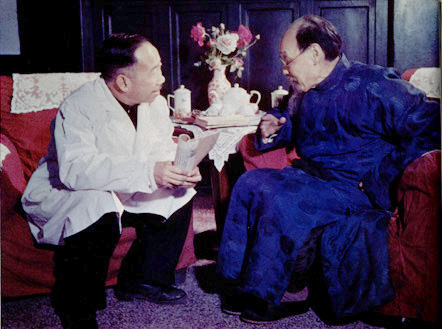

|
In the first decades of the twentieth century, many of the elite families of China sent their children abroad for study. Western ideas of modernization and industrialization became familiar to a whole generation of young educated elite in China, and many of them came to associate western styles of dress with modernity. While some people fully adopted western style dress, others took to wearing clothes that retained symbolically important elements of traditional dress. | |||||

To the right is a cartoon from a magazine in the 1920s showing a "modern" day couple. What do you notice about the clothing styles? Take a close look at the first frame. Can you guess what is happening in this frame? What do you think the figures in the background represent?
| |||||
|
|||||
|
Many of the social, political, and artistic leaders in the early decades of the twentieth century had studied abroad. Song Qingling, the intellectual and political activist of the revolutionary period and the wife of revolutionary leader Sun Yat-sen, studied in the U.S. Below are two photos of her. The photo on the left was taken while she was a student at Wesleyan College in Macon, Georgia. In the photo on the right Song Qingling sits to the left of her two sisters Song Meiling (the future wife of Chiang Kai-shek) and Song Ailing (who married Shanghai financier H.H.Kung) after her return to China. In looking at these two photos, what differences do you notice in how clothing carried markers of gender, wealth, and fashion-consciousness? Why do you think Song Qingling would change back to a Chinese clothing style when she returned to China from her studies in America? | |||||
|
Notice anything about these women's shoes?
|
|||||
|
During the political upheaval of the early twentieth century, Chinese men frequently expressed their political allegiances through the clothes they wore. Below is an old photo of a meeting of Nationalist Party (Guomindang) political leaders. How many different styles of dress are illustrated in this photo? What different political allegiances do you think their clothing reflects? | |||||
|
| |||||
| |||||
| To the right is a
photo of two doctors, one specializing in traditional medicine,
the other in modern, Western medicine.
Is it surprising that a practitioner of traditional Chinese medicine would also choose to dress in a traditional way? |
 | ||||
| |||||
|
During the twentieth century certain modes of dress were adopted in an attempt to integrate both traditional Chinese and western cultural influences. The most influential were the qipao for women and the Mao suit. Today, however, many men wear western-style suits, just as women wear western-style clothing. | |||||
|
|
|||||